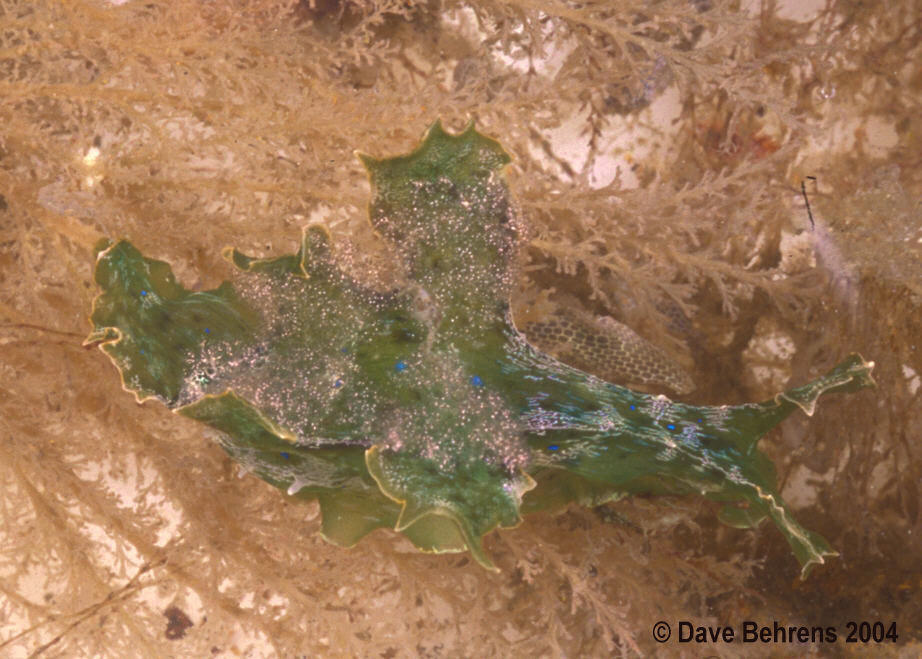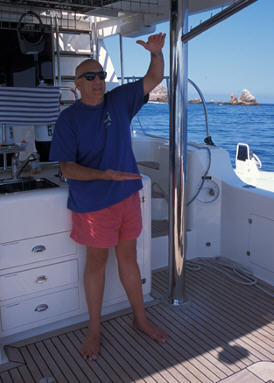 |
Crosslandia daedali
Photo courtesy of Dave Behrens
Lazaro Cardinas, Eastern Pacific, Mexico
March 2004
Crosslandia daedali Poorman & Mulliner, 1981
Members of the dendronotid family Scyllaeidae are some of the most interesting and yet taxonomically confusing species of opisthobranchs. On a recent "Branching Expedition" to Zihuatanejo, Mexico, Brancher buddy
Ali Hermosillo and I collected both scyllaeid species: Crosslandia daedali and Notobryon wardi. This week we'd like to revisit Crosslandia daedali which Orso Campillo shared in
BOW 258 , here. A Notobryon BOW is coming soon.
Steve Drogin onboard Destiny

|
First a few Thank You's. Ali and I would like to thank Steve Drogin (at left) for inviting us to stay on his magnificent boat,
Destiny , while in the romantic Mexican coastal town of Zihaut. Steve has always been real nudibranch advocate and generous contributor to
the Slug Site over the years having submitted images to make possible eight Branch of the Week (BOW) presentations. You may remember his fantastic shot of
Tambja sp.
from Kungkungan Bay, and the shot taken by Steve's fiancée,
Hiroko Shimada, of the
Ceratosoma trilobatum
from ChiChi Jima Island,
in Japan. My favorite of Steve's 8 or so BOW's of course is
Chromodoris dianae named for my wife, Diana. Thanks Steve.
We ran across our first Crosslandia in a most unusual way. We had been diving some 90 kms north of Zihaut, near the small village of Caleta de Campos. The variety of habitat types there produced a number of surprises including the magnificent ovulid snail, Turbovula lenorea . This lovely, colorful critter matches is soft coral prey to a "T". While returning to Zihaut we passed a large offshore navigational buoy off the industrial port of Lazaro Cardinas. As every good Brancher knows, artificial substrates like floating docks, boat hulls and buoys support luxurious populations of filter feeding organism like hydroids, bryozoans and sponges. Well Ali just had to check it out. Following all the "Good Diving Practices" of never dive alone, plan your dive and never exceed you capabilities, Ali jumped in and swam to the bottom of the anchor chain in 80 feet of water. Fighting the swell and surge she did manage to scrape about a gallon of growth off the chain. She was so excited to see if there were any Branchs, she starting sorting the sample before she was even out of her wet suit. Her efforts landed us, two undescribed species of Doto , and undescribed Cuthona and this gorgeous Crosslandia. |
Crosslandia has two large, wing-like lobes on the parapodia, the anterior lobe being larger than the posterior. The color varies from greenish to brown-orange . This species has both fine chestnut brown longitudinal lines and white lines on the sides and undersides of lobes. A key distinctive feature are it's six small, round brilliant blue spots between the parapodia. There are also about five along the sides. These spots have a fine black ring around them. There is also row of 4-6 conical tubercles along the side of the body. The really fascinating feature of this creature anatomy is the gill structure. If you didn't know what to look for you would likely miss it all together. Look closely between the parapodial lobes and you will see a forest of transparent branched tufts, which are the gills. These tuffs give the appearance of hydroids growing on the animals back.
Early on this species was thought to be an herbivore as it is usually found on grazing on algae. Closer observation showed that they are actually feed on epiphytic hydroids growing on the algae.
This species reaches 30 mm in length and ranges from Bahía Tortugas and Punta Eugenia on the Pacific side of Baja California Peninsula down the coast of Central America to Costa Rica.
Danville, Calif
Apr. 2004
Taxonomic information courtesy of:

David W. Behrens
Author:
Pacific Coast Nudibranchs
Send Dave mail at dave@seachallengers.com
|
